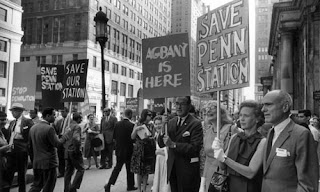Attrition of Automobiles
The introduction of The Death and Life of Great American Cities by Jane Jacobs, starts out by saying it is an attack on city planning and rebuilding. With that statement, it sets the tone of the entire book. We expect controversial and heavy debate. Jane Jacobs does not fail to deliver on her promise. However, she does not simply attack but provides solutions. I appreciate this. She offers new ideas and alternatives to her rivals. In the introduction, she targets three plans: the Garden City – Ebenezer Howard; : the Radiant City – Le Corbusier;: the City Beautiful – Daniel Burnham. Jacobs focuses on the reality of the city not the idea of the city. She felt the plans of city planners would destroy the city itself. She viewed these developers as a disease causing decay in the body of the city.
One example she refers to is in New York’s East Harlem. There is a housing project with a rectangle lawn. The lawn has grass and would appear to add value to the area however the residents hate it. They feel it has no useful purpose. The overwhelming fact is that the planners did not even ask the potential residents what they wanted, they just decided that the lawn would make them happy.
Jacobs recounts her visits to the North End in Boston considered one of the biggest slums at the time (1950s). She revisited there in 1959 and finds it a transformed area. Everything had been rehabilitated. The statics confirmed what she saw. However because it was once considered a slum, it would always been viewed as a slum by the politicians, business owners, and bankers.
Jane Jacobs (in glasses) at a protest.
Chapter 18
The chapter starts with the statement, “Today everyone who values cities is disturbed by automobiles.” However according to Jacobs, it is easy to blame automobiles for the problems in most cities. She states there are two basic needs of a city, transportation and communication. Unfortunately, both are not easily achieved. Where would we be without automobiles? The other day as I was stuck in traffic, I was wondering how much easier life must have been before we all had cars. This was before I read this chapter. I didn’t think about the things this chapter brings to life. Travel before cars meant walking or horses. Horses meant mud, noise, smells and crowding. Can you imagine, a thousand horses on the Ike? I would rather be in my car with the windows rolled up and listening to my iPod.
One pedestrian scheme, Jacobs describes is The Gruen Plan for the downtown area of Fort Worth. It was planned to reduce traffic in the area. It included having expressways circling downtown Fort Worth with 6 feeder garages for thousands of cars. The plan would free automobiles in the downtown area allowing people to walk freely. Plans, like these, appear to enhance the city but have many issues. One issue the lack of servicing and supplying the city itself. Another issue is isolating the downtown area and planning for expansion.
While Jacobs supports the use of automobiles, she explains the side effects of their use. Congestion and parking are two issues. Due to these issues, we are forced to build wider roads and more parking garages which erode the city. More space is needed as we increase our dependence on automobiles. In Los Angles, the highways are constantly jammed due to congestion which causes accidents which causes congestion. It is an endless cycle
According to Jane Jacobs, "Automobiles are often conveniently tagged as the villains responsible for the ills of cities and the disappointments and futilities of city planning. But the destructive effects of automobiles are much less a cause than a symptom of our incompetence at city building.” If we build cities that are less dependent on automobiles, we will not rely on them as much. One of Jacobs’ biggest opponents was Robert Moses. Jacobs and Moses battled over the Lower Manhattan Expressway. Moses plan was to build a 10 lane expressway through lower Manhattan. Jacobs and her allies won the battle. One side note, even though Robert Moses was considered a pioneer in roadway development, he did not ever possess a driver’s license.
Map of the Lower Manhattan Expressway
Of course, Jacobs’ book was written in 1961. A lot has happen since then in the automobile industry. We starting to come around to Jacob’s thinking. We are abandoning the large, fuel guzzling SUVs for more efficient, environment friendly vehicles. We are starting to have a better understanding for how our automobile use affects the erosion of our city. To stop the erosion of cities, we must reduce our dependency on automobiles.
In the introduction, Jane Jacob’s ask “How can you know what to try with traffic until you know how the city itself works, and what else it needs to do with its street?” She answers – “You can’t.” Jacobs does not believe if you solve the traffic issues of the city, you solve all the problems of the city. I agree with her. Traffic is a huge problem no matter where you live but it is far from the biggest issue facing a city. Issues such as crime, poverty, hunger or homelessness are far greater problems and should demand more attention from our city planners and government.
Robert Moses returns Jacobs’ book to Random House. Letter refers to
Page 131 of her book, The Death and Life of Great American Cities.
Page 131 of her book, The Death and Life of Great American Cities.
“Robert Moses, who genius at getting things done largely consists in understanding this, has made an art of using control of public money to get his way with those who the voters elect and depend
on to represent their frequently opposing interests.”
on to represent their frequently opposing interests.”



No comments:
Post a Comment